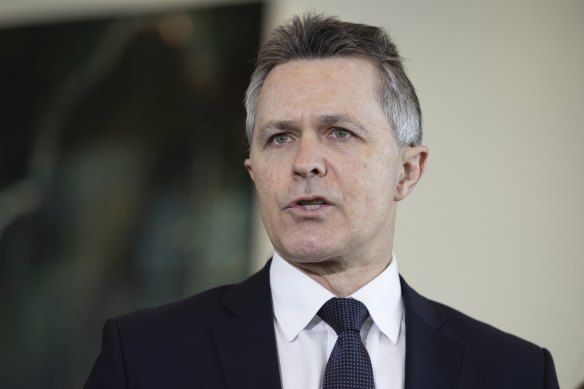This was published 10 months ago
The number of Australians with student debts above $100,000 revealed
The number of Australians with student loans exceeding $100,000 has more than doubled in just five years as the country’s outstanding debts soar beyond $81 billion.
The latest data from the Australian Tax Office reveals almost 57,000 Australians have higher education loan program (HELP) debts of more than $100,000 compared to 22,514 in 2018-19.
It is also becoming increasingly common for students to amass debts of more than $50,000. Five years ago just 7 per cent of student debts were above $50,000 compared to 14 per cent last financial year.
Labor has faced political pressure from independents and the Greens to unwind Morrison government Job-ready Graduates reforms, which have seen the cost of arts degrees soar to above $50,000, and address unmanageable student debts.
The government recently introduced legislation to wipe $3 billion in debt by retrospectively lowering the 7.1 per cent indexation applied to student debts in 2023 to 3.2 per cent. It will also mean the indexation rate applied in 2024 will be cut from 4.7 per cent to 4 per cent.
Student debt indexation is linked to the rate of inflation, but the legislation would mean it would be capped at either the wage price index or inflation – whichever is lower.

Education Minister Jason ClareCredit: Alex Ellinghausen
Australian National University higher education expert Andrew Norton said the increase in the number of people with high debts could in part be attributed to students embarking on expensive postgraduate degrees too soon after they finish their undergraduate studies.
“Also, while there has been huge increases in voluntary repayments over the past few years, it’s mainly people with smaller debts managing to clear their debts,” he said, “while people with higher debts are copping indexation on high balances.”
He said the high cost of degrees for arts, business and law students would probably keep the number of people with debts above $50,000 high.
“Then if they do postgraduate degrees their debt will be even higher … making them vulnerable for very high debts for the rest of their lives,” Norton said.
Education Minister Jason Clare said a proposed new body – Australian Tertiary Education Commission – would steer further reform around HECS, including setting the cost of degrees.
“The ATEC is the appropriate body to do this work,” he said.
But Norton said – based on the time needed to set up the proposed ATEC – it appeared unlikely the government would unwind Job-ready fee hikes for degrees like arts before 2027.
HELP debt includes all forms of student loans including HECS – which is for the student contribution of government funded university places – and those for full-fee postgraduate degrees.
The average HELP debt rose to $27,640 last financial year, up on $26,494 the year prior and $21,557 five years ago.
The Australian Taxation Office data revealed there were more than $1.9 billion in voluntary repayments last financial year on top of the record $2.9 billion the year before.
It shows the average length of time to fully repay student debt has reached 9.9 years, up on 9.2 years five years ago.
Western Sydney University vice-chancellor George Williams urged the government to take immediate action to reverse the escalating costs of arts degrees, which will cost more than $50,000 for students starting next year.
“How does this imbalance, impacting equity groups, serve the minister’s commitment to make the system ‘fairer’?” he said.
“The debt incurred for gateway and foundation-style degrees works against the government’s stated aim of encouraging more equity and diverse students into university to reach its target of 80 per cent of the working age population with tertiary qualifications by 2050.”
In a submission to a Senate inquiry, Sydney University said the government’s changes to indexation would modestly improve affordability but noted Labor was yet to commit to addressing the underlying cause of growing debt burden.
“Until the government addresses the inequities of the [the Morrison government job-ready reforms], Commonwealth-supported students enrolling in many popular courses face HELP debts of between
$50,000 and $90,000 for their first degrees alone,” it read.
Economics professor Bruce Chapman, a founder of the HECS system, said the high fees for primarily humanities degrees was the single most important issue facing the sector.
“Female humanities students have the lowest lifetime earnings of all graduates and they’re the ones with the highest debts,” he said.
“It’s very inequitable”.
Chapman, along with Australian National University colleagues Tim Higgins and Gaurav Khemka, is developing different degree pricing structures they say would address this inequality.
The long-awaited government-commissioned University Accord review this year recommended scrapping the Job-ready Graduates scheme, finding it left students with high debts which were not reflected in their future salary potential.
Start the day with a summary of the day’s most important and interesting stories, analysis and insights. Sign up for our Morning Edition newsletter.